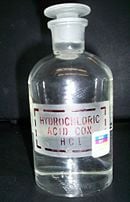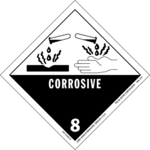Hydrochloric acid
| Hydrochloric acid | |
|---|---|

| |
| General | |
| Systematic name | Hydrochloric acid |
| Other names | Muriatic acid, Spirit of salt |
| Molecular formula | HCl in water (H2O) |
| Molar mass | 36.46 g/mol (HCl) |
| Appearance | Clear colorless to light-yellow liquid |
| CAS number | [7647-01-0] |
| Properties | |
| Density, phase | 1.18 g/cm³, 37% solution. |
| Solubility in water | Fully miscible. |
| Melting point | −26 °C (247 K) 38% solution. |
| Boiling point | 110 °C (383 K), 20.2% solution; 48 °C (321 K), 38% solution. |
| Acid dissociation constant pKa |
−8.0 |
| Viscosity | 1.9 mPa·s at 25 °C, 31.5% solution |
| Hazards | |
| MSDS | External MSDS |
| NFPA 704 |
32–38% solution |
| Main Hazards | Highly corrosive. |
| Flash point | Non-flammable. |
| R/S statement | R34, R37, S26, S36, S45 |
| RTECS number | MW4025000 |
| Supplementary data page | |
| Structure and properties |
n, εr, etc. |
| Thermodynamic data |
Phase behavior Solid, liquid, gas |
| Spectral data | UV, IR, NMR, MS |
| Related compounds | |
| Other anions | HF, HBr, HI |
| Other cations | N/a |
| Related acids | Hydrobromic acid Hydrofluoric acid Hydroiodic acid Sulfuric acid |
| Except where noted otherwise, data are given for materials in their standard state (at 25 °C, 100 kPa) Infobox disclaimer and references | |
The chemical compound hydrochloric acid (or muriatic acid) is the aqueous (water-based) solution of hydrogen chloride gas (HCl). This strong acid is highly corrosive and must be handled with appropriate safety precautions. It is the major component of gastric acid. It is routinely used in chemical research laboratories and manufacturing plants. Its applications include the large-scale production of certain compounds (such as vinyl chloride for polyvinyl chloride (PVC) plastic), removal of rust and scale from metals, petroleum production, and ore processing. Smaller-scale applications include the production of gelatin and other ingredients in food, and leather processing. An estimated 20 million metric tons of hydrochloric acid are produced annually.
History
Hydrochloric acid was first discovered around 800 C.E. by the alchemist Jabir ibn Hayyan (Geber), by mixing common salt with vitriol (sulfuric acid). Jabir discovered many important chemicals, and recorded his findings in over 20 books, which carried his chemical knowledge of hydrochloric acid and other basic chemicals for hundreds of years. Jabir's invention of the gold-dissolving aqua regia, consisting of hydrochloric acid and nitric acid, was of great interest to alchemists searching for the philosopher's stone.
In the Middle Ages, hydrochloric acid was known to European alchemists as spirit of salt or acidum salis. Gaseous HCl was called marine acid air. The old (pre-systematic) name muriatic acid has the same origin (muriatic means "pertaining to brine or salt"), and this name is still sometimes used. Notable production was recorded by Basilius Valentinus, the alchemist-canon of the Benedictine priory Sankt Peter in Erfurt, Germany in the fifteenth century. In the seventeenth century, Johann Rudolf Glauber from Karlstadt am Main, Germany used sodium chloride salt and sulfuric acid for the preparation of sodium sulfate in the Mannheim process, releasing hydrogen chloride gas. Joseph Priestley of Leeds, England prepared pure hydrogen chloride in 1772, and in 1818 Humphry Davy of Penzance, England proved that the chemical composition included hydrogen and chlorine.
During the Industrial Revolution in Europe, demand for alkaline substances such as soda ash increased, and the new industrial soda process by Nicolas Leblanc (Issoundun, France) enabled cheap, large-scale production. In the Leblanc process, salt is converted to soda ash using sulfuric acid, limestone, and coal. Hydrogen chloride is released as a by-product. Until the Alkali Act of 1863, excess HCl was vented to the air. After passage of the act, soda ash producers were obliged to absorb the waste gas in water, producing hydrochloric acid on an industrial scale.
When early in the twentieth century the Leblanc process was effectively replaced by the Solvay process without the hydrochloric acid by-product, hydrochloric acid was already fully settled as an important chemical in numerous applications. The commercial interest initiated other production methods that are still used today, as described below. Today, most hydrochloric acid is made by absorbing hydrogen chloride from industrial organic compounds production.
Hydrochloric acid is listed as a Table II precursor under the 1988 Convention Against Illicit Traffic in Narcotic Drugs and Psychotropic Substances because of its use in the production of drugs such as heroin, cocaine, and methamphetamine.
Chemistry
Hydrogen chloride (HCl) is a monoprotic acid, which means that each molecule can dissociate (ionize) only once to release one H+ ion (a single proton). In aqueous hydrochloric acid, the H+ joins a water molecule to form a hydronium ion, H3O+:
- HCl + H2O ⇌ H3O+ + Cl−
The other ion formed is Cl−, the chloride ion. Hydrochloric acid can therefore be used to prepare salts called chlorides, such as sodium chloride. Hydrochloric acid is a strong acid, since it is fully dissociated in water.
Monoprotic acids have one acid dissociation constant, Ka, which indicates the level of dissociation in water. For a strong acid like HCl, the Ka is large. Theoretical attempts to assign a Ka to HCl have been made. When chloride salts such as NaCl are added to aqueous HCl they have practically no effect on pH, indicating that Cl− is an exceedingly weak conjugate base and that HCl is fully dissociated in aqueous solution. For intermediate to strong solutions of hydrochloric acid, the assumption that H+ molarity (a unit of concentration) equals HCl molarity is excellent, agreeing to four significant digits.
Of the seven common strong acids in chemistry, all of them inorganic, hydrochloric acid is the monoprotic acid least likely to undergo an interfering oxidation-reduction reaction. It is one of the least hazardous strong acids to handle; despite its acidity, it produces the less reactive and non-toxic chloride ion. Intermediate strength hydrochloric acid solutions are quite stable, maintaining their concentrations over time. These attributes, plus the fact that it is available as a pure reagent, mean that hydrochloric acid makes an excellent acidifying reagent and acid titrant (for determining the amount of an unknown quantity of base in titration). Strong acid titrants are useful because they give more distinct endpoints in a titration, making the titration more precise. Hydrochloric acid is frequently used in chemical analysis and to digest samples for analysis. Concentrated hydrochloric acid will dissolve some metals to form oxidized metal chlorides and hydrogen gas. It will produce metal chlorides from basic compounds such as calcium carbonate or copper(II) oxide. It is also used as a simple acid catalyst for some chemical reactions.
Physical properties
The physical properties of hydrochloric acid, such as boiling and melting points, density, and pH depend on the concentration or molarity of HCl in the acid solution. They can range from those of water at 0 percent HCl to values for fuming hydrochloric acid at over 40 percent HCl.
| Conc. (w/w) c : kg HCl/kg |
Conc. (w/v) c : kg HCl/m3 |
Conc. Baumé |
Density ρ : kg/l |
Molarity M |
pH |
Viscosity η : mPa·s |
Specific heat s : kJ/(kg·K) |
Vapor pressure PHCl : Pa |
Boiling point b.p. |
Melting point m.p. |
| 10% | 104.80 | 6.6 | 1.048 | 2.87 M | -0.5 | 1.16 | 3.47 | 0.527 | 103 °C | -18 °C |
| 20% | 219.60 | 13 | 1.098 | 6.02 M | -0.8 | 1.37 | 2.99 | 27.3 | 108 °C | -59 °C |
| 30% | 344.70 | 19 | 1.149 | 9.45 M | -1.0 | 1.70 | 2.60 | 1,410 | 90 °C | -52 °C |
| 32% | 370.88 | 20 | 1.159 | 10.17 M | -1.0 | 1.80 | 2.55 | 3,130 | 84 °C | -43 °C |
| 34% | 397.46 | 21 | 1.169 | 10.90 M | -1.0 | 1.90 | 2.50 | 6,733 | 71 °C | -36 °C |
| 36% | 424.44 | 22 | 1.179 | 11.64 M | -1.1 | 1.99 | 2.46 | 14,100 | 61 °C | -30 °C |
| 38% | 451.82 | 23 | 1.189 | 12.39 M | -1.1 | 2.10 | 2.43 | 28,000 | 48 °C | -26 °C |
Hydrochloric acid as the binary (two-component) mixture of HCl and H2O has a constant-boiling azeotrope at 20.2 percent HCl and 108.6 °C (227 °F). There are four constant-crystallization eutectic points for hydrochloric acid, between the crystal form of HCl·H2O (68 percent HCl), HCl·2H2O (51 percent HCl), HCl·3H2O (41 percent HCl), HCl·6H2O (25 percent HCl), and ice (0 percent HCl). There is also a metastable eutectic point at 24.8 percent between ice and the HCl·3H2O crystallization
Production
Hydrochloric acid is prepared by dissolving hydrogen chloride in water. Hydrogen chloride can be generated in many ways, and thus several different precursors to hydrochloric acid exist. The large scale production of hydrochloric acid is almost always integrated with other industrial scale chemicals production.
Industrial market
Hydrochloric acid is produced in solutions up to 38 percent HCl (concentrated grade). Higher concentrations up to just over 40 percent are chemically possible, but the evaporation rate is then so high that storage and handling need extra precautions, such as pressure and low temperature. Bulk industrial-grade is therefore 30 percent to 34 percent, optimized for effective transport and limited product loss by HCl vapors. Solutions for household purposes, mostly cleaning, are typically 10 percent to 12 percent, with strong recommendations to dilute before use.
Major producers worldwide include Dow Chemical at 2 million metric tons annually (2 Mt/year), calculated as HCl gas, and FMC, Georgia Gulf Corporation, Tosoh Corporation, Akzo Nobel, and Tessenderlo at 0.5 to 1.5 Mt/year each. Total world production, for comparison purposes expressed as HCl, is estimated at 20 Mt/year, with 3 Mt/year from direct synthesis, and the rest as secondary product from organic and similar syntheses. By far, most of all hydrochloric acid is consumed captively by the producer. The open world market size is estimated at 5 Mt/year.
Applications
Hydrochloric acid is a strong inorganic acid that is used in many industrial processes. The application often determines the required product quality.
Regeneration of ion exchangers
An important application of high-quality hydrochloric acid is the regeneration of ion exchange resins. Cation exchange is widely used to remove ions such as Na+ and Ca2+ from aqueous solutions, producing demineralized water.
- Na+ is replaced by H3O+
- Ca2+ is replaced by 2 H3O+
Ion exchangers and demineralized water are used in all chemical industries, drinking water production, and many food industries.
pH Control and neutralization
A very common application of hydrochloric acid is to regulate the basicity (pH) of solutions.
- OH− + HCl → H2O + Cl−
In industry demanding purity (food, pharmaceutical, drinking water), high-quality hydrochloric acid is used to control the pH of process water streams. In less-demanding industry, technical-quality hydrochloric acid suffices for neutralizing waste streams and swimming pool treatment.
Pickling of steel
Pickling is an essential step in metal surface treatment, to remove rust or iron oxide scale from iron or steel before subsequent processing, such as extrusion, rolling, galvanizing, and other techniques. Technical-quality HCl at typically 18 percent concentration is the most commonly-used pickling agent for the pickling of carbon steel grades.
- Fe2O3 + Fe + 6 HCl → 3 FeCl2 + 3 H2O
The spent acid has long been re-used as ferrous chloride solutions, but high heavy-metal levels in the pickling liquor has decreased this practice.
In recent years, the steel pickling industry has however developed hydrochloric acid regeneration processes, such as the spray roaster or the fluidized bed HCl regeneration process, which allow the recovery of HCl from spent pickling liquor. The most common regeneration process is the pyrohydrolysis process, applying the following formula:
- 4 FeCl2 + 4 H2O + O2 → 8 HCl+ 2 Fe2O3
By recuperation of the spent acid, a closed acid loop is established. The ferric oxide by product of the regeneration process is a valuable by-product, used in a variety of secondary industries.
HCl is not a common pickling agent for stainless steel grades.
Production of inorganic compounds
Numerous products can be produced with hydrochloric acid in normal acid-base reactions, resulting in inorganic compounds. These include water treatment chemicals such as iron(III) chloride and polyaluminium chloride (PAC).
- Fe2O3 + 6 HCl → 2 FeCl3 + 3 H2O
Both iron(III) chloride and PAC are used as flocculation and coagulation agents in wastewater treatment, drinking water production, and paper production.
Other inorganic compounds produced with hydrochloric acid include road application salt calcium chloride, nickel(II) chloride for electroplating, and zinc chloride for the galvanizing industry and battery production.
Production of organic compounds
The largest hydrochloric acid consumption is in the production of organic compounds such as vinyl chloride for PVC, and MDI and TDI for polyurethane. This is often captive use, consuming locally-produced hydrochloric acid that never actually reaches the open market. Other organic compounds produced with hydrochloric acid include bisphenol A for polycarbonate, activated carbon, and ascorbic acid, as well as numerous pharmaceutical products.
Other applications
Hydrochloric acid is a fundamental chemical, and as such it is used for a large number of small-scale applications, such as leather processing, household cleaning, and building construction. In addition, a way of stimulating oil production is by injecting hydrochloric acid into the rock formation of an oil well, dissolving a portion of the rock, and creating a large-pore structure. Oil-well acidizing is a common process in the North Sea oil production industry.
Many chemical reactions involving hydrochloric acid are applied in the production of food, food ingredients, and food additives. Typical products include aspartame, fructose, citric acid, lysine, hydrolyzed (vegetable) protein as food enhancer, and in gelatin production. Food-grade (extra-pure) hydrochloric acid can be applied when needed for the final product.
Physiology and pathology
Hydrochloric acid constitutes the majority of gastric acid, the human digestive fluid. In a complex process and at a large energetic burden, it is secreted by parietal cells (also known as oxyntic cells). These cells contain an extensive secretory network (called canaliculi) from which the HCl is secreted into the lumen of the stomach. They are part of the fundic glands (also known as oxyntic glands) in the stomach.
Safety mechanisms that prevent the damage of the epithelium of digestive tract by hydrochloric acid are the following:
- Negative regulators of its release
- A thick mucus layer covering the epithelium
- Sodium bicarbonate secreted by gastric epithelial cells and pancreas
- The structure of epithelium (tight junctions)
- Adequate blood supply
- Prostaglandins (many different effects: they stimulate mucus and bicarbonate secretion, maintain epithelial barrier integrity, enable adequate blood supply, stimulate the healing of the damaged mucous membrane)
When, due to different reasons, these mechanisms fail, heartburn or peptic ulcers can develop. Drugs called proton pump inhibitors prevent the body from making excess acid in the stomach, while antacids neutralize existing acid.
In some instances, not enough of hydrochloric acid gets produced in the stomach. These pathologic states are denoted by the terms hypochlorhydria and achlorhydria. Potentially they can lead to gastroenteritis.
Chemical weapons
Phosgene (COCl2) was a common chemical warfare agent used in World War I. The main effect of phosgene results from the dissolution of the gas in the mucous membranes deep in the lung, where it is converted by hydrolysis into carbonic acid and the corrosive hydrochloric acid. The latter disrupts the alveolar-capillary membranes so that the lung becomes filled with fluid (pulmonary edema).
Hydrochloric acid is also partly responsible for the harmful or blistering effects of mustard gas. In the presence of water, such as on the moist surface of the eyes or lungs, mustard gas breaks down to form hydrochloric acid.
Safety
| Dangerous goods labels | |
|---|---|
 
| |
Hydrochloric acid in high concentrations forms acidic mists. Both the mist and the solution have a corrosive effect on human tissue, potentially damaging respiratory organs, eyes, skin and intestines. Upon mixing hydrochloric acid with common oxidizing chemicals, such as bleach (NaClO) or permanganate (KMnO4), the toxic gas chlorine is produced. To minimize the risks while working with hydrochloric acid, appropriate precautions should be taken, including wearing rubber or PVC gloves, protective eye goggles, and chemical resistant clothing.
The hazards of solutions of hydrochloric acid depend on the concentration. The following table lists the EU classification of hydrochloric acid solutions:
| Concentration by weight |
Classification | R-Phrases |
|---|---|---|
| 10%–25% | Irritant (Xi) | R36/37/38 |
| >25% | Corrosive (C) | R34 R37 |
See also
ReferencesISBN links support NWE through referral fees
- Chang, Raymond. 2006. Chemistry, 9th ed. New York: McGraw-Hill Science/Engineering/Math. ISBN 0073221031.
- Cotton, F. Albert, and Geoffrey Wilkinson. 1980. Advanced Inorganic Chemistry, 4th ed. New York: Wiley. ISBN 0471027758.
- Guyton, Arthur C., and John E. Hall. 2000. Textbook of Medical Physiology. Philadelphia: Saunders. ISBN 072168677X.
- Lide, David R., ed. 2005. CRC Handbook of Chemistry and Physics, 86th ed. Boca Raton: CRC Press. ISBN 0849304865.
- McMurry, J., and R.C. Fay. 2004. Chemistry, 4th ed. Upper Saddle River, NJ: Prentice Hall. ISBN 0131402080.
- Perry, R., D. Green, and J. Maloney. 1984. Perry's Chemical Engineers' Handbook, 6th ed. New York: McGraw-Hill. ISBN 0070494797.
Credits
New World Encyclopedia writers and editors rewrote and completed the Wikipedia article in accordance with New World Encyclopedia standards. This article abides by terms of the Creative Commons CC-by-sa 3.0 License (CC-by-sa), which may be used and disseminated with proper attribution. Credit is due under the terms of this license that can reference both the New World Encyclopedia contributors and the selfless volunteer contributors of the Wikimedia Foundation. To cite this article click here for a list of acceptable citing formats.The history of earlier contributions by wikipedians is accessible to researchers here:
The history of this article since it was imported to New World Encyclopedia:
Note: Some restrictions may apply to use of individual images which are separately licensed.



